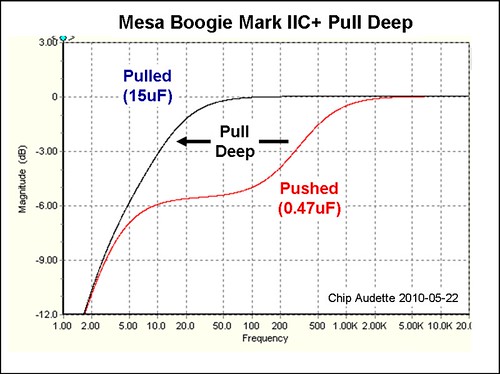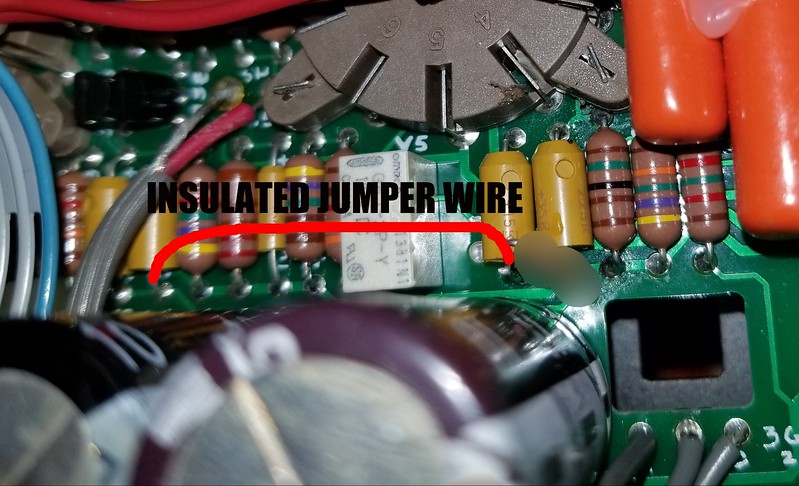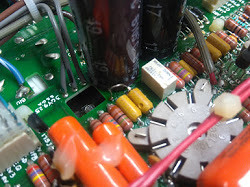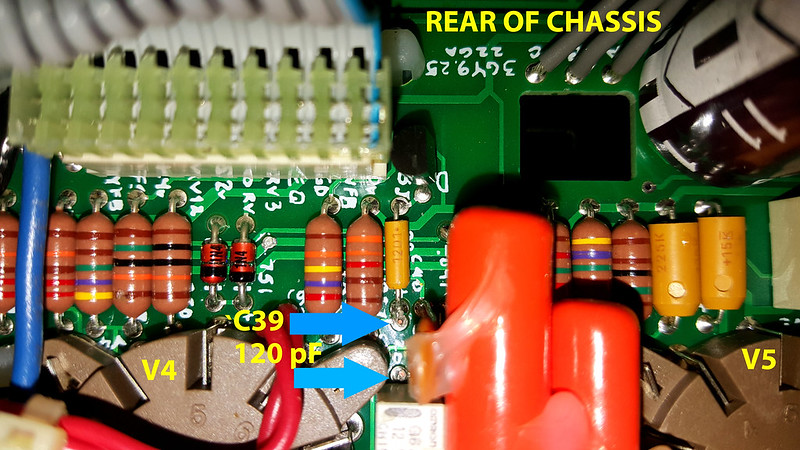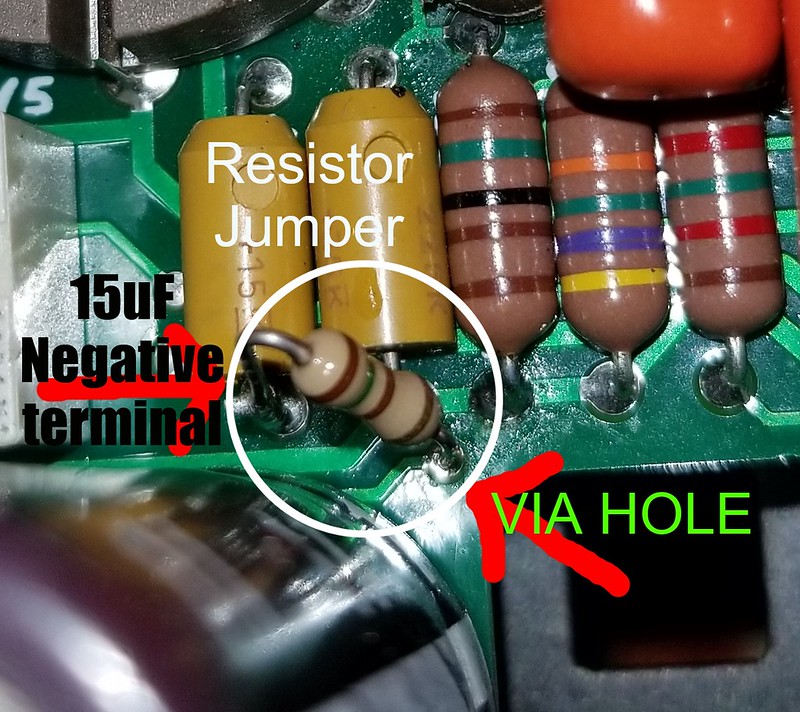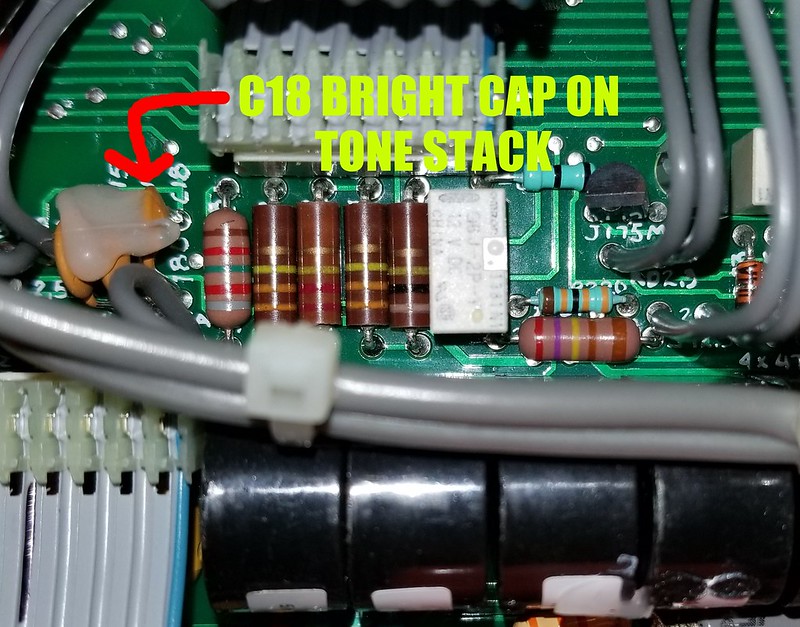Wayno
Well-known member
Been busy with the soldering iron today :twisted: and i'm happy to report no drama's 8)
The Mark V is now even more of a beast!
Done a straight jumper (wire not resistor) on the same lines as Bandits V6a cathode mod. All modes on ch3 are beefier now, iiC+ is much closer to what it should be,well how i would run it on a real iiC+ anyway. iV is like Bandit said "insane" and Extreme just rips your face off even more than it already did. Not sure whether or not i'm going to play with the EQ coupling cap yet as i like the clear difference between the modes that i have at the moment. We'll see. For now i'm very happy.
I have a naff quality phone recording to put up in a mo so i welcome your feedback.
Mods i have installed;
V4 Jan GE AT7
C39 removed
V6A Cathode caps jumped
Tubes as follows;
V1 Tungsol
V2 Stock Mesa
V3 Stock Mesa
V4 Jan GE 12AT7
V5 Stock Mesa
V6 Stock Mesa
V7 Sovtek LPS
V8-11 JJ EL34ii
Thought i'd go back to pretty much stock for recording a little clip so as to give a pretty standard result rather than having a concoction of different tubes in there.
Also been thinking further about the Caps on V1a cathode but have been leaning towards the mindset that adding more low end to the first stage is probably going to overload the bass response too early and just result in flub. After reading the following post in this thread ( http://www.forum.grailtone.com/viewtopic.php?f=3&t=67396 ) it reaffirmed my suspicions,
From Chipaudette;
"In both cases, the bass shift and pull deep knobs connect a capacitor into the circuit. So, with the knob pushed in, the capacitors are not in the circuit (ie, they have no effect) and with the knob pulled out, the capacitors in are in the circuit (ie, they do have an effect).
In both cases, the capacitor is being added to the "cathode" portion of each tube. You'll note that in both cases there is also a resistor and a small capacitor already connecting between the tube's cathode pin and ground. This resistor and capacitor control the low-frequency roll-off of that gain stage. The small value of the capacitor means that (when the knob is pushed in) the low frequencies are attenuated.
When you pull the knob, it brings the bigger valued capacitor. This pushes the low-frequency roll-off of that gain stage to be much lower (way lower) in frequency. As a result, the bass is stronger and deeper.
In the case of the "Pull Shift" on the bass knob, pulling the knob makes this part of the circuit look like the corresponding portion of a classic blackface Fender from the 60s (e.g. Deluxe Reverb or Twin Reverb), which is what the Mark series was originally based on.
Mesa decided to alter this part of the circuit because, with all that bass, the Boogie's overdriven lead sound was too flabby for some people. Therefore, by switching to a smaller cathode cap, it removed some bass prior to the lead circuit, which made the lead sound more smooth. For those who still wanted the Fender clean sound, the gave you "Pull Shift" to be able to bring that deep bass back into the sound, if you wanted.
In the case of the "Pull Deep" knob, this is doing exactly the same trick, but it happens to occur after the effects loop (which is also after the lead circuit). Being after the lead circuit, it does not have the same "flabby / not-flabby" effect on the lead tone. Here, its effect on the bass is simply a matter of whether you like more low-mids and bass frequencies or whether you like less. Do you like beefy girth, or do you like a more focused and slicing sound? It's your call.
Chip"
So in effect i have the Pull Deep engaged on all modes of ch3 with the V6a cathode jumper mod. Pull Shift activates the bigger cap on V1a which is what i was considering before. Think i'll leave that one alone. Maybe the Jfet there (J175A) is what gets switched in between Clean and Fat modes on Ch1 maybe?
DO NOT attempt this if you are not familiar with valve/tube amps and the very real danger of electrocution and DEATH. DO NOT attempt this if you are not comfortable with soldering on tightly populated circuit boards. If you are not comfortable with either as mentioned before but still want the mods done, get a tech to do it for you.
The Mark V is now even more of a beast!
Done a straight jumper (wire not resistor) on the same lines as Bandits V6a cathode mod. All modes on ch3 are beefier now, iiC+ is much closer to what it should be,well how i would run it on a real iiC+ anyway. iV is like Bandit said "insane" and Extreme just rips your face off even more than it already did. Not sure whether or not i'm going to play with the EQ coupling cap yet as i like the clear difference between the modes that i have at the moment. We'll see. For now i'm very happy.
I have a naff quality phone recording to put up in a mo so i welcome your feedback.
Mods i have installed;
V4 Jan GE AT7
C39 removed
V6A Cathode caps jumped
Tubes as follows;
V1 Tungsol
V2 Stock Mesa
V3 Stock Mesa
V4 Jan GE 12AT7
V5 Stock Mesa
V6 Stock Mesa
V7 Sovtek LPS
V8-11 JJ EL34ii
Thought i'd go back to pretty much stock for recording a little clip so as to give a pretty standard result rather than having a concoction of different tubes in there.
Also been thinking further about the Caps on V1a cathode but have been leaning towards the mindset that adding more low end to the first stage is probably going to overload the bass response too early and just result in flub. After reading the following post in this thread ( http://www.forum.grailtone.com/viewtopic.php?f=3&t=67396 ) it reaffirmed my suspicions,
From Chipaudette;
"In both cases, the bass shift and pull deep knobs connect a capacitor into the circuit. So, with the knob pushed in, the capacitors are not in the circuit (ie, they have no effect) and with the knob pulled out, the capacitors in are in the circuit (ie, they do have an effect).
In both cases, the capacitor is being added to the "cathode" portion of each tube. You'll note that in both cases there is also a resistor and a small capacitor already connecting between the tube's cathode pin and ground. This resistor and capacitor control the low-frequency roll-off of that gain stage. The small value of the capacitor means that (when the knob is pushed in) the low frequencies are attenuated.
When you pull the knob, it brings the bigger valued capacitor. This pushes the low-frequency roll-off of that gain stage to be much lower (way lower) in frequency. As a result, the bass is stronger and deeper.
In the case of the "Pull Shift" on the bass knob, pulling the knob makes this part of the circuit look like the corresponding portion of a classic blackface Fender from the 60s (e.g. Deluxe Reverb or Twin Reverb), which is what the Mark series was originally based on.
Mesa decided to alter this part of the circuit because, with all that bass, the Boogie's overdriven lead sound was too flabby for some people. Therefore, by switching to a smaller cathode cap, it removed some bass prior to the lead circuit, which made the lead sound more smooth. For those who still wanted the Fender clean sound, the gave you "Pull Shift" to be able to bring that deep bass back into the sound, if you wanted.
In the case of the "Pull Deep" knob, this is doing exactly the same trick, but it happens to occur after the effects loop (which is also after the lead circuit). Being after the lead circuit, it does not have the same "flabby / not-flabby" effect on the lead tone. Here, its effect on the bass is simply a matter of whether you like more low-mids and bass frequencies or whether you like less. Do you like beefy girth, or do you like a more focused and slicing sound? It's your call.
Chip"
So in effect i have the Pull Deep engaged on all modes of ch3 with the V6a cathode jumper mod. Pull Shift activates the bigger cap on V1a which is what i was considering before. Think i'll leave that one alone. Maybe the Jfet there (J175A) is what gets switched in between Clean and Fat modes on Ch1 maybe?
DO NOT attempt this if you are not familiar with valve/tube amps and the very real danger of electrocution and DEATH. DO NOT attempt this if you are not comfortable with soldering on tightly populated circuit boards. If you are not comfortable with either as mentioned before but still want the mods done, get a tech to do it for you.




